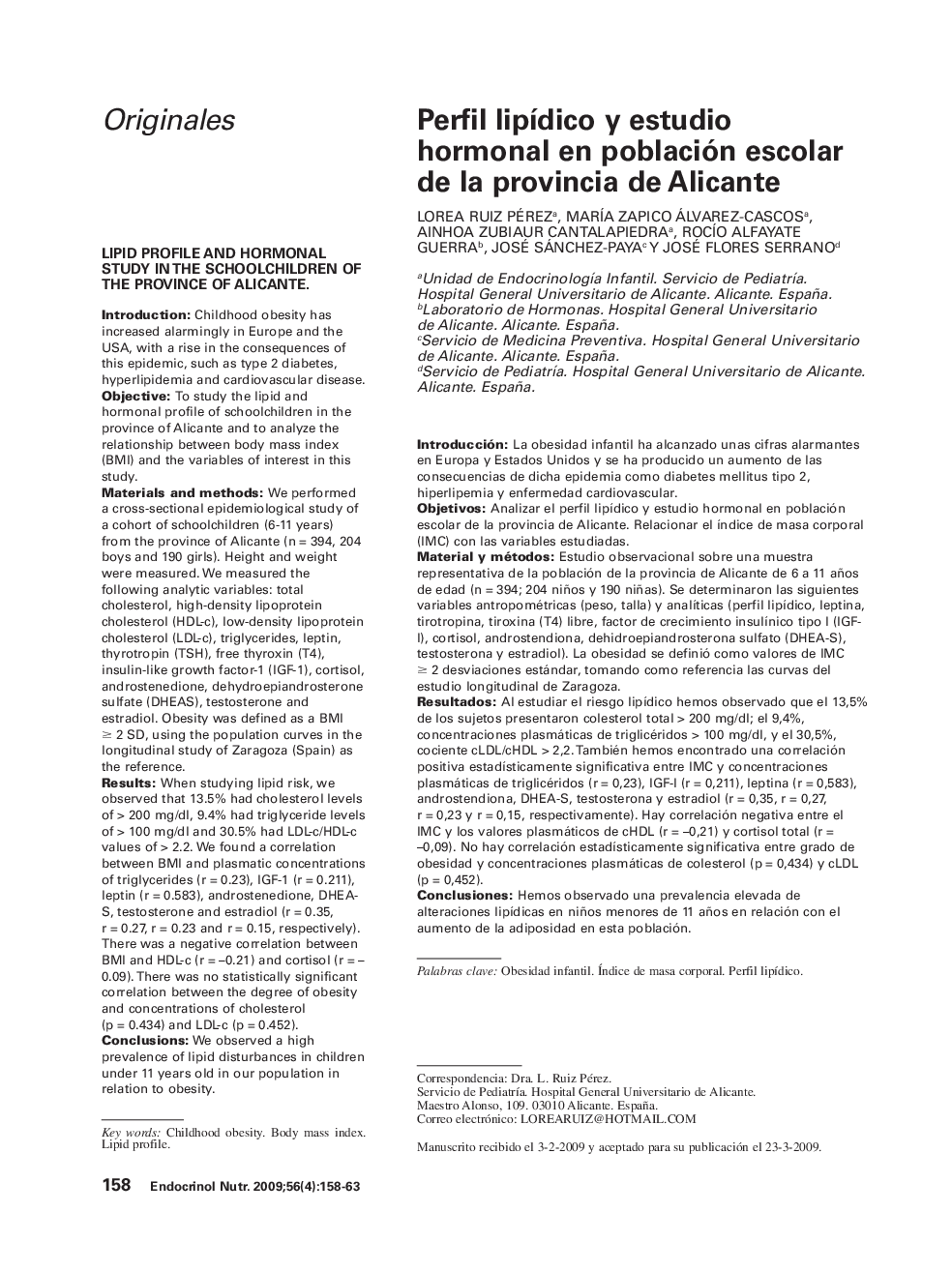| کد مقاله | کد نشریه | سال انتشار | مقاله انگلیسی | نسخه تمام متن |
|---|---|---|---|---|
| 2774546 | 1152223 | 2009 | 6 صفحه PDF | دانلود رایگان |

IntroducciónLa obesidad infantil ha alcanzado unas cifras alarmantes en Europa y Estados Unidos y se ha producido un aumento de las consecuencias de dicha epidemia como diabetes mellitus tipo 2, hiperlipemia y enfermedad cardiovascular.ObjetivosAnalizar el perfil lipídico y estudio hormonal en población escolar de la provincia de Alicante. Relacionar el índice de masa corporal (IMC) con las variables estudiadas.Material y métodosEstudio observacional sobre una muestra representativa de la población de la provincia de Alicante de 6 a 11 años de edad (n = 394; 204 niños y 190 niñas). Se determinaron las siguientes variables antropométricas (peso, talla) y analíticas (perfil lipídico, leptina, tirotropina, tiroxina (T4) libre, factor de crecimiento insulínico tipo I (IGFI), cortisol, androstendiona, dehidroepiandrosterona sulfato (DHEA-S), testosterona y estradiol). La obesidad se definió como valores de IMC ≥ 2 desviaciones estándar, tomando como referencia las curvas del estudio longitudinal de Zaragoza.ResultadosAl estudiar el riesgo lipídico hemos observado que el 13,5% de los sujetos presentaron colesterol total > 200 mg/dl; el 9,4%, concentraciones plasmáticas de triglicéridos > 100 mg/dl, y el 30,5%, cociente cLDL/cHDL > 2,2. También hemos encontrado una correlación positiva estadísticamente significativa entre IMC y concentraciones plasmáticas de triglicéridos (r = 0,23), IGF-I (r = 0,211), leptina (r = 0,583), androstendiona, DHEA-S, testosterona y estradiol (r = 0,35, r = 0,27, r = 0,23 y r = 0,15, respectivamente). Hay correlación negativa entre el IMC y los valores plasmáticos de cHDL (r = −0,21) y cortisol total (r = −0,09). No hay correlación estadísticamente significativa entre grado de obesidad y concentraciones plasmáticas de colesterol (p = 0,434) y cLDL (p = 0,452).ConclusionesHemos observado una prevalencia elevada de alteraciones lipídicas en niños menores de 11 años en relación con el aumento de la adiposidad en esta población.
IntroductionChildhood obesity has increased alarmingly in Europe and the USA, with a rise in the consequences of this epidemic, such as type 2 diabetes, hyperlipidemia and cardiovascular disease.ObjectiveTo study the lipid and hormonal profile of schoolchildren in the province of Alicante and to analyze the relationship between body mass index (BMI) and the variables of interest in this study.Materials and methodsWe performed a cross-sectional epidemiological study of a cohort of schoolchildren (6-11 years) from the province of Alicante (n = 394, 204 boys and 190 girls). Height and weight were measured. We measured the following analytic variables: total cholesterol, high-density lipoprotein cholesterol (HDL-c), low-density lipoprotein cholesterol (LDL-c), triglycerides, leptin, thyrotropin (TSH), free thyroxin (T4), insulin-like growth factor-1 (IGF-1), cortisol, androstenedione, dehydroepiandrosterone sulfate (DHEAS), testosterone and estradiol. Obesity was defined as a BMI ≥ 2 SD, using the population curves in the longitudinal study of Zaragoza (Spain) as the reference.ResultsWhen studying lipid risk, we observed that 13.5% had cholesterol levels of > 200 mg/dl, 9.4% had triglyceride levels of > 100 mg/dl and 30.5% had LDL-c/HDL-c values of > 2.2. We found a correlation between BMI and plasmatic concentrations of triglycerides (r = 0.23), IGF-1 (r = 0.211), leptin (r = 0.583), androstenedione, DHEAS, testosterone and estradiol (r = 0.35, r = 0.27, r = 0.23 and r = 0.15, respectively). There was a negative correlation between BMI and HDL-c (r = −0.21) and cortisol (r = −0.09). There was no statistically significant correlation between the degree of obesity and concentrations of cholesterol (p = 0.434) and LDL-c (p = 0.452).ConclusionsWe observed a high prevalence of lipid disturbances in children under 11 years old in our population in relation to obesity.
Journal: Endocrinología y Nutrición - Volume 56, Issue 4, April 2009, Pages 158–163